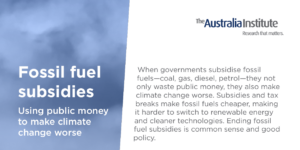New research shows our 2030 emission targets are woefully out of date
The evidence is clear – our current policies and targets are insufficient to prevent dangerous global warming, and not aligned with latest scientific research.
New research, published in the leading climate science journal Nature Climate Change, has shown that at current levels of emissions, the global carbon budget to keep the world at 1.5°C of warming will be exhausted in just 6 years.
What does this research mean for Australia?
It means we need to radically increase our climate ambition.
In 2022, the Labor government introduced a target of 43% reductions from 2005 levels by 2030, and “net zero” by 2050. But this will not be enough to keep warming below 1.5°C. Our carbon budget is shrinking with every passing month. The longer we delay making the necessary cuts, the harder the job becomes.
Even more concerning in this context is that recent analysis suggests Australia’s leading climate policy, the Safeguard Mechanism, won’t result in direct emissions cuts until the end of the decade. Too little, too late.
If all countries followed the same trajectory as Australia’s targets, the world would emit more than 2000 gigatons of carbon before reaching net zero. This would give us only a 50:50 chance of limiting warming to 2.5°C. Remember that every fraction of a degree past 1.5°C and closer to 2°C takes us deeper into the dangerous world of tipping points, and cascading failures of climate and eco-systems.
The talk of net zero by 2050 needs to end.
In the words of Anote Tong, former president of Kiribati, “Half a degree of warming may seem trifling but, for my country, Kiribati, these fractional figures are a matter of life and death.” If we are to stand with our Pacific neighbours and limit warming to as close to 1.5°C as possible, we need to reach net zero by 2035 at the absolute latest.
This is a monumental task that needs to be treated as such by governments. We need to radically reshape our economy, and we need to push back against the greed of fossil-fuel companies. Most importantly we cannot afford to expand coal and gas production at such a critical juncture.
Our current targets are insufficient to achieve our international commitments, or to ensure we pass on a liveable planet to future generations
Every cut in emissions now increases the chances of limiting temperature rises.
In a 2019 speech, Chris Bowen – then Shadow Minister for Health, now Minister for Climate Change and Energy – repeated what a doctor had said to him: “ignoring the science of climate change would be akin to supporting anti-vaxxers.”
Let’s hope he’s listening to the science of climate change now.
Related research
Between the Lines Newsletter
The biggest stories and the best analysis from the team at the Australia Institute, delivered to your inbox every fortnight.
You might also like
Climate target malpractice. Cooking the books and cooking the planet.
As the Albanese government prepares to announce Australia’s 2035 climate target, pressure is mounting to show greater ambition.
Fossil fuel subsidies
When governments subsidise fossil fuels—coal, gas, diesel, petrol—they not only waste public money, they also make climate change worse. Subsidies and tax breaks make fossil fuels cheaper, making it harder to switch to renewable energy and cleaner technologies. Ending fossil fuel subsidies is common sense and good policy.
Why a fossil fuel-free COP could put Australia’s bid over the edge
When the medical world hosts a conference on quitting smoking, they don’t invite Phillip Morris, or British American Tobacco along to help “be part of the solution”.



